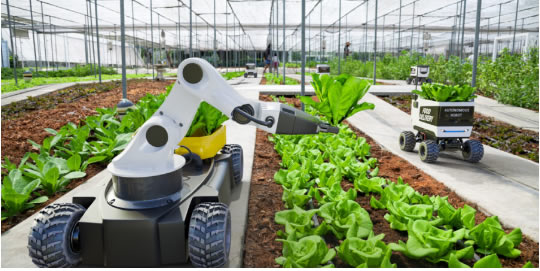How Robots are used in Agriculture

The agricultural industry are continually looking for ways to increase output, improve efficiency and reduce waste. This has led to robots and automation becoming an integral part of farming and food production processes.
Application of robots in agriculture
Robots have a wide range of applications within the agricultural industry from performing complex tasks such as monitoring crops and measuring PH levels in the soil, to simpler tasks of picking-and-packing fruits and vegetables and planting seeds. Add to that automation for ventilation systems and air control for livestock, milk production and arable irrigation, and it is clear that technology is the future for successful agriculture.
Robots and automation are particularly important for large, industrialised farms where there is a lot of land to monitor and work as well as processing large amounts of crops or produce. Currently robots perform a number of tasks including:
- Seeding – Driverless tractors and robots are slowly replacing driver-led machinery for sowing seeds.
- Harvesting – A primary use of robots on farms especially with the current labour shortage often comprises of a robot with picking arms to pick ripened fruit and vegetables.
- Packing – Packing fruit and vegetables for distribution to retail is often carried out by the use of a conveyor belt and robotic arms to pack the produce according to type. They can be programmed to identify good from bad produce so only the best ends up in the supermarket.
- Palletising – This is normally carried out by a forklift truck and driver and is therefore also automated in many instances using palletising robots or robotic arms.
- Crop maintenance – Robots can be programmed to maintain the crops by pruning plants, weeding land, applying insecticides or nutrients and providing irrigation.
- Livestock applications – There are many repetitive tasks involved with livestock farming which can be automated including milking cows, spreading feed and monitoring land for grazing.
Benefits of robots in agriculture
Whilst there is obviously the initial financial outlay when automating agricultural systems there are a number of benefits including:
- Productivity – Robots can work quicker than humans and for longer periods without a reduction in productivity, risk of injury or a need for breaks.
- Guaranteed workers – With seasonal tasks like fruit-picking it can be difficult to find the staff on time, whereas robots are available to pick the produce when it is ready with no risk of a crop being left in the ground to rot.
- Waste reduction – If crops are left in the ground due to staff shortages, or they are not palletised in time for distribution this can result in wasted crops. This won’t happen with automation.
- Precision – Robots are not susceptible to human error and therefore repetitive jobs (and even more complex tasks) will be done accurately and precisely throughout the entire process.
- Cost effective – Although the outlay could be high, with robots running 24/7 this investment is quickly returned, as farms will be working more efficiently, with reduced waste, reduced labour and reduced running costs.
Designing robots for agricultural applications
Motors are a key component that enable robots to be able to perform their tasks, driving their robotic arms enabling them to move, grip & pick to undertake precision tasks.
When designing robots, manufactures need to ensure that the motors installed with the robot are perfect for the job in hand.
At Parvalux we offer a range of geared motors which are trusted globally by the leading agricultural ventilation and feed delivery system manufacturers because they are robust and reliable.
We have also just introduced a new range of brushed DC motors, the BRx42, which are designed for robotic applications with 2 different sizes, torque capabilities over a variety of voltages. Search our website to see the full BRx42 family of motors https://www.parvalux.com/search/brx42/
Comments (0)
This post does not have any comments. Be the first to leave a comment below.
Featured Product

